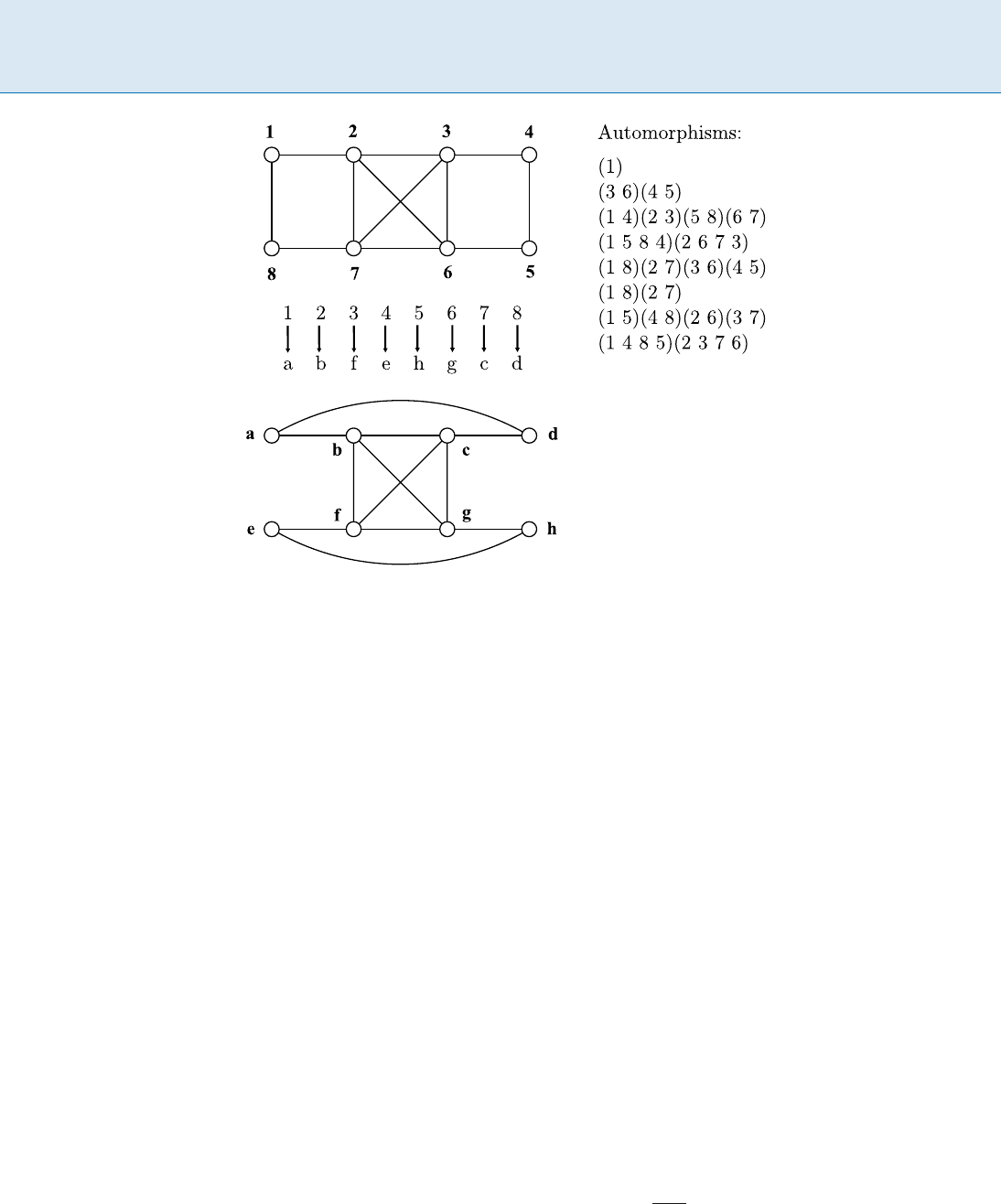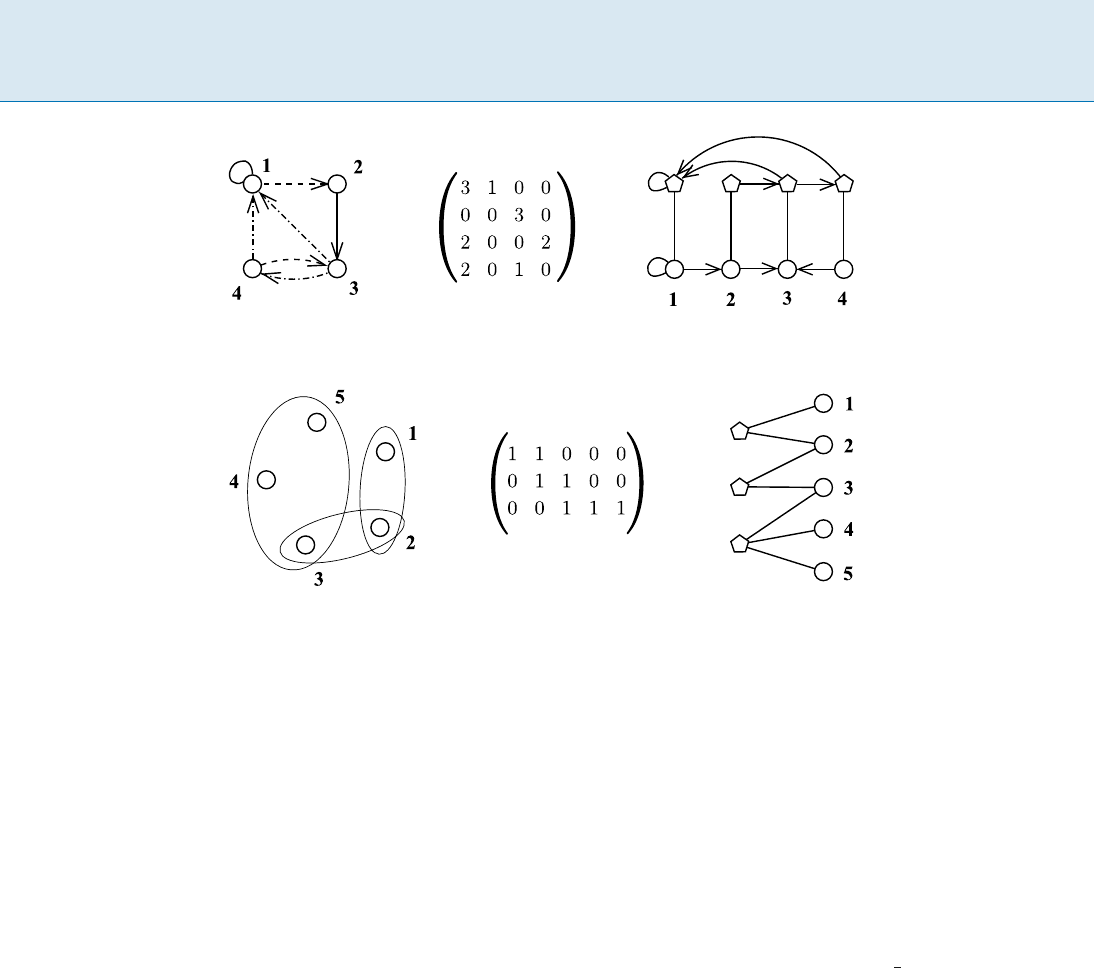Kao M.-Y. (ed.) Encyclopedia of Algorithms
Подождите немного. Документ загружается.


368 G Graph Coloring
9. Gupta, A.: Improved bandwidth approximation for trees and
chordal graphs. J. Algorithms 40(1), 24–36 (2001)
10. Krauthgamer, R., Lee, J.R., Mendel, M., Naor, A.: Measured de-
scent: A new embedding method for finite metrics. Geom.
Funct. Anal. 15(4), 839–858 (2005)
11. Krauthgamer, R., Linial, N., Magen, A.: Metric embeddings–
beyond one-dimensional distortion. Discrete Comput. Geom.
31(3), 339–356 (2004)
12. Lee, J.R.: Volume distortion for subsets of Euclidean spaces.
In: Proceedings of the 22nd Annual Symposium on Computa-
tional Geometry, ACM, Sedona, AZ 2006, pp. 207–216.
13. Linial, N.: Finite metric-spaces—combinatorics, geometry and
algorithms. In: Proceedings of the International Congress of
Mathematicians, vol. III, Beijing, 2002, pp. 573–586. Higher Ed.
Press, Beijing (2002)
14. Linial, N., London, E., Rabinovich, Y.: The geometry of graphs
and some of its algorithmic applications. Combinatorica 15(2),
215–245 (1995)
15. Papadimitriou, C.H.: The NP-completeness of the bandwidth
minimization problem. Computing 16(3), 263–270 (1976)
16. Rao, S.: Small distortion and volume preserving embeddings
for planar and Euclidean metrics. In: Proceedings of the 15th
Annual Symposium on Computational Geometry, pp. 300–
306. ACM, New York (1999)
17. Strang, G.: Linear algebra and its applications, 2nd edn. Aca-
demic Press [Harcourt Brace Jovanovich Publishers], New York
(1980)
18. Unger, W.: The complexity of the approximation of the band-
width problem. In: 39th Annual Symposium on Foundations of
Computer Science, IEEE, 8–11 Oct 1998, pp. 82–91.
19. Vempala, S.: Random projection: A new approach to VLSI lay-
out. In: 39th Annual Symposium on Foundations of Computer
Science, IEEE, 8–11 Oct 1998, pp. 389–398.
Graph Coloring
1994; Karger, Motwani, Sudan
1998; Karger, Motwani, Sudan
MICHAEL LANGBERG
Department of Computer Science,
The Open University of Israel,
Raanana, Israel
Keywords and Synonyms
Clique cover
Problem Definition
An independent set in an undirected graph G =(V; E)is
a set of vertices that induce a subgraph which does not
contain any edges. The size of the maximum independent
set in G is denoted by ˛(G). For an integer k,ak-coloring
of G is a function : V ! [1 :::k] which assigns colors
to the vertices of G.Avalidk-coloring of G is a coloring
in which each color class is an independent set. The chro-
matic number (G)ofG is the smallest k for which there
exists a valid k-coloring of G.Finding(G)isafundamen-
tal NP-hard problem. Hence, when limited to polynomial
time algorithms, one turns to the question of estimating
the value of (G) or to the closely related problem of ap-
proximate coloring.
Problem 1 (Approximate coloring)
I
NPUT:UndirectedgraphG=(V; E).
O
UTPUT: A valid coloring of G with r (G) colors, for
some approximation ratio r 1.
O
BJECTIVE: Minimize r.
Let G be a graph of size n. The approximate coloring of G
can be solved efficiently within an approximation ratio of
r = O
n(log log n)
2
log
3
n
[12]. This holds also for the approxi-
mation of ˛(G)[8]. These results may seem rather weak,
however it is NP-hard to approximate ˛(G)and(G)
within a ratio of n
1"
for any constant ">0[9,14,21]. Un-
der stronger complexity assumptions, there is some con-
stant 0 <ı<1 such that neither problem can be approx-
imated within a ratio of n/2
log
ı
n
[17,21]. This chapter will
concentrate on the problem of coloring graphs G for which
(G)issmall. As will be seen, in this case the approxima-
tion ratio achievable significantly improves.
Vector Coloring of Graphs
The algorithms achieving the best ratios for approximate
coloring when (G)issmall[1,3,13,15] are all based on
the idea of vector coloring, introduced by Karger, Motwani,
and Sudan [15]
1
Definition 1 A vector k-coloring of a graph is an assign-
ment of unit vectors to its vertices,such that for every edge,
the inner product of the vectors assigned to its endpoints
is at most (in the sense that it can only be more negative)
1/(k 1).
The vector chromatic number
!
(G)ofG is the smallest k
for which there exists a vector k-coloring of G. The vector
chromatic number can be formulated as follows:
!
(G) Minimize k
subject to : hv
i
; v
j
i
1
k 1
8(i; j) 2 E
hv
i
; v
i
i =1 8i 2 V:
Here, assume that V =[1;:::;n] and that the vectors
fv
i
g
n
i=1
are in R
n
. Every k-colorable graph is also vector
1
Vector coloring as presented in [15] is closely related to the
Lovász function [19]. This connection will be discussed shortly.

Graph Coloring G 369
k-colorable. This can be seen by identifying each color
class with one vertex of a perfect (k 1)-dimensional sim-
plex centered at the origin. Moreover, unlike the chro-
matic number, a vector k-coloring (when it exists) can
be found in polynomial time using semidefinite program-
ming (up to an arbitrarily small error in the inner prod-
ucts).
Claim 1 (Complexity of vector coloring [15]) Let ">0.
If a graph G has a vector k-coloring then a vector (k + ")-
coloring of the graph can be constructed in time polynomial
innandlog(1/").
One can strengthen Definition 1 to obtain a different no-
tion of vector coloring and the vector chromatic number.
!
2
(G) Minimize k
subject to: hv
i
; v
j
i =
1
k 1
8(i; j) 2 E
hv
i
; v
i
i =1 8i 2 V
!
3
(G) Minimize k
subject to: hv
i
; v
j
i =
1
k 1
8(i; j) 2 E
hv
i
; v
j
i
1
k 1
8i; j 2 V
hv
i
; v
i
i =1 8i 2 V:
The function
!
2
(G) is referred to as the strict vec-
tor chromatic number of G and is equal to the Lovász
function on
¯
G [15,19], where
¯
G is the complement
graph of G.Thefunction
!
3
(G) is referred to as the
strong vector chromatic number. An analog to Claim 1
holds for both
!
2
(G)and
!
3
(G). Let !(G)denote
thesizeofthemaximumcliqueinG,itholdsthat:
!(G)
!
(G)
!
2
(G)
!
3
(G) (G).
Key Results
In what follows, assume that G has n vertices and max-
imal degree .The
˜
O()and
˜
˝()notationareusedto
suppress polylogarithmic factors. The key result of Karger,
Motwani, and Sudan [15] is stated below:
Theorem 1 ([15]) If
!
(G)=kthenGcanbecoloredin
polynomial time using minf
˜
O(
12/k
),
˜
O(n
13/(k+1)
)gcol-
ors.
As mentioned above, the use of vector coloring in the con-
text of approximate coloring was initiated in [15]. Roughly
speaking, once given a vector coloring of G, the heart of
the algorithm in [15] finds a large independent set in G.In
a nutshell, this independent set corresponds to a set of vec-
tors in the vector coloring which are close to one another
(and thus by definition cannot share an edge). Combin-
ing this with the ideas of Wigderson [20] mentioned below
yields Theorem 1.
A description of related work is given below. The first
two theorems below appeared prior to the work of Karger,
Motwani, and Sudan [15].
Theorem 2 ([20]) If (G)=kthenGcanbecoloredin
polynomial time using O(kn
11/(k1)
) colors.
Theorem 3 ([2]) If (G)=3then G can be colored in
polynomial time using
˜
O(n
3/8
) colors. If (G)=k 4
then G can be colored in polynomial time using at most
˜
O(n
11/(k3/2)
) colors.
Combining the techniques of [15]and[2] the following
results were obtained for graphs G with (G)=3; 4(these
results were also extended for higher values of (G)).
Theorem 4 ([3]) If (G)=3then G can be colored in
polynomial time using
˜
O(n
3/14
) colors.
Theorem 5 ([13]) If (G)=4then G can be colored in
polynomial time using
˜
O(n
7/19
) colors.
The currently best-known result for coloring a 3-colorable
graph is presented in [1]. In their algorithm, [1]usethe
strict vector coloring relaxation (i. e.
!
2
)enhancedwith
certain odd cycle constraints.
Theorem 6 ([1]) If (G)=3then G can be colored in
polynomial time using O(n
0:2111
) colors.
To put the above theorems in perspective, it is NP-hard to
color a 3-colorable graph G with 4 colors [11,16]andak-
colorable graph (for sufficiently large k)withk
(log k)/25
col-
ors [17]. Under stronger complexity assumptions (related
to the Unique Games Conjecture [18]) for any constant k
it is hard to color a k-colorable graph with any constant
number of colors [6].Thewidegapbetweenthesehard-
ness results and the approximation ratios presented in this
section has been a major initiative in the study of approxi-
mate coloring.
Finally, the limitations of vector coloring are ad-
dressed. Namely, are there graphs for which
!
(G)is
a poor estimate of (G)? One would expect the answer
to be “yes” as estimating (G) beyond a factor of n
1"
is a hard problem. As will be stated below, this is indeed
the case (even when
!
(G) is small). Some of the results
that follow are stated in terms of the maximum indepen-
dent set ˛(G)inG.As(G) n/˛(G), these results im-

370 G Graph Coloring
ply a lower bound on (G). Theorem 1 (i) states that the
original analysis of [15] is essentially tight. Theorem 1
(ii) presents bounds for the case of
!
(G)=3.Theorem1
(iii) and Theorem 2 present graphs G in which there is
an extremely large gap between (G) and the relaxations
!
(G)and
!
2
(G).
Theorem 7 ([10]) (i) For every constant ">0 and
constant k > 2, there are infinitely many graphs G with
!
(G)=kand˛(G) n/
12/k"
(here >n
ı
for
some constant ı>0). (ii) There are infinitely many graphs
Gwith
!
(G)=3and ˛(G) n
0:843
. (iii) For some con-
stant c, there are infinitely many graphs G with
!
(G)=
O(log n/loglogn) and ˛(G) log
c
n.
Theorem 8 ([7]) For some constant c, there are infinitely
many graphs G with
!
2
(G) 2
p
log n
and (G)
n/2
c
p
log n
.
Vector colorings, including the Lovász function and its
variants, have been extensively studied in the context of
approximation algorithms for problems other than Prob-
lem 1. These include approximating ˛(G), approximating
the Minimum Vertex Cover problem, and combinatorial
optimization in the context of random graphs.
Applications
Besides its theoretical significance, graph coloring has sev-
eral concrete applications that fall under the model of con-
flict free allocation of resources (see for example [4,5]).
Open Problems
By far the major open problem in the context of approx-
imate coloring addresses the wide gap between what is
known to be hard and what can be obtained in polyno-
mial time. The case of constant (G) is especially intrigu-
ing, as the best-known upper bounds (on the approxima-
tion ratio) are polynomial while the lower bounds are of
constant nature. Regarding the vector coloring paradigm,
a majority of the results stated in Sect. “Key Results”use
the weakest form of vector coloring
!
(G) in their proof,
while stronger relaxations such as
!
2
(G)and
!
3
(G)may
also be considered. It would be very interesting to improve
upon the algorithmic results stated above using stronger
relaxations, as would a matching analysis of the limitations
of these relaxations.
Cross References
Channel Assignment and Routing in Multi-Radio
Wireless Mesh Networks
Max Cut
Randomized Rounding
Sparsest Cut
Recommended Reading
1. Arora, S., Chlamtac, E., Charikar, M.: New approximation guar-
antee for chromatic number. In: Proceedings of the 38th
annual ACM Symposium on Theory of Computing (2006)
pp. 215–224.
2. Blum, A.: New approximations for graph coloring. J. ACM 41(3),
470–516 (1994)
3. Blum, A., Karger, D.: An
˜
O(n
3/14
)-coloring for 3-colorable
graphs. Inf. Process. Lett. 61(6), 49–53 (1997)
4. Chaitin, G.J.: Register allocation & spilling via graph coloring.
In: Proceedings of the 1982 SIGPLAN Symposium on Compiler
Construction (1982) pp. 98–105.
5. Chaitin,G.J.,Auslander,M.A.,Chandra,A.K.,Cocke,J.,Hopkins,
M.E., Markstein, P.W.: Register allocation via coloring. Comp.
Lang. 6, 47–57 (1981)
6. Dinur, I., Mossel, E., Regev, O.: Conditional hardness for approx-
imate coloring. In: Proceedings of the 38th annual ACM Sym-
posium on Theory of Computing (2006) pp. 344–353.
7. Feige, U.: Randomized graph products, chromatic numbers,
and the Lovász theta function. Combinatorica 17(1), 79–90
(1997)
8. Feige, U.: Approximating maximum clique by removing sub-
graphs.SIAMJ.Discret.Math.18(2), 219–225 (2004)
9. Feige, U., Kilian, J.: Zero knowledge and the chromatic number.
J. Comput. Syst. Sci. 57, 187–199 (1998)
10. Feige, U., Langberg, M., Schechtman, G.: Graphs with tiny vec-
tor chromatic numbers and huge chromatic numbers. SIAM J.
Comput. 33(6), 1338–1368 (2004)
11. Guruswami, V., Khanna, S.: On the hardness of 4-coloring
a 3-colorable graph. In: Proceedings of the 15th annual IEEE
Conference on Computational Complexity (2000) pp. 188–197.
12. Halldorsson, M.: A still better performance guarantee for
approximate graph coloring. Inf. Process. Lett. 45, 19–23
(1993)
13. Halperin, E., Nathaniel, R., Zwick, U.: Coloring k-colorable
graphs using smaller palettes. J. Algorithms 45, 72–90 (2002)
14. Håstad, J.: Clique is hard to approximate within n
1"
.Acta
Math. 182(1), 105–142 (1999)
15. Karger,D.,Motwani,R.,Sudan,M.:Approximategraphcoloring
by semidefinite programming. J. ACM 45(2), 246–265 (1998)
16. Khanna, S., Linial, N., Safra, S.: On the hardness of approx-
imating the chromatic number. Combinatorica 20, 393–415
(2000)
17. Khot, S.: Improved inapproximability results for max clique,
chromatic number and approximate graph coloring. In: Pro-
ceedings of the 42nd annual IEEE Symposium on Foundations
of Computer Science (2001) pp. 600–609.
18. Khot, S.: On the power of unique 2-prover 1-round games. In:
Proceedings of the 34th annual ACM symposium on Theory of
Computing (2002) pp. 767–775.
19. Lovász, L.: On the Shannon capacity of a graph. IEEE Trans. Inf.
Theor. 25, 2–13 (1979)
20. Wigderson, A.: Improving the performance guarantee for ap-
proximate graph coloring. J. ACM 30(4), 729–735 (1983)

Graph Connectivity G 371
21. Zuckerman, D.: Linear degree extractors and the inapproxima-
bility of max clique and chromatic number. In: Proceedings
of the 38th annual ACM symposium on Theory of Computing
(2006) pp. 681–690.
Graph Connectivity
1994; Khuller, Vishkin
SAMIR KHULLER
1
,BALAJI RAGHAVACHARI
2
1
Computer Science Department, University
of Maryland, College Park, MD, USA
2
Computer Science Department, University of Texas
at Dallas, Richardson, TX, USA
Keywords and Synonyms
Highly connected subgraphs; Sparse certificates
Problem Definition
An undirected graph is said to be k-connected (specifi-
cally, k-vertex-connected) if the removal of any set of k 1
or fewer vertices (with their incident edges) does not dis-
connect G. Analogously, it is k-edge-connected if the re-
moval of any set of k 1 edges does not disconnect G.
Menger’s theorem states that a k-vertex-connected graph
has at least k openly vertex-disjoint paths connecting ev-
ery pair of vertices. For k-edge-connected graphs there are
k edge-disjoint paths connecting every pair of vertices.The
connectivity of a graph is the largest value of k for which
it is k-connected. Finding the connectivity of a graph, and
finding k disjoint paths between a given pair of vertices can
be found using algorithms for maximum flow. An edge is
said to be critical in a k-connected graph if upon its re-
moval the graph is no longer k-connected.
The problem of finding a minimum-cardinality k-
vertex-connected (k-edge-connected) subgraph that spans
all vertices of a given graph is called k-VCSS (k-ECSS) and
is known to be nondeterministic polynomial-time hard for
k 2. We review some results in finding approximately
minimum solutions to k-VCSS and k-ECSS. We focus pri-
marily on simple graphs. A simple approximation algo-
rithm is one that considers the edges in some order and
removes edges that are not critical. It thus outputs a k-con-
nected subgraph in which all edges are critical and it can
be shown that it is a 2-approximation algorithm (that out-
puts a solution with at most kn edges in an n-vertex graph,
and since each vertex has to have degree at least k,wecan
claim that kn/2 edges are necessary).
Approximation algorithms that do better than the sim-
ple algorithm mentioned above can be classified into two
categories: depth first search (DFS) based, and matching
based.
Key Results
Lower Bounds for k-Connected Spanning Subgraphs
Each node of a
k-connected graph has at least k edges in-
cident to it. Therefore, the sum of the degrees of all its
nodes is at least kn,wheren is the number of its nodes.
Since each edge is counted twice in this degree-sum, the
cardinality of its edges is at least kn/2.Thisiscalledthede-
gree lower bound. Expanding on this idea yields a stronger
lower bound on the cardinality of a k-connected spanning
subgraph of a given graph. Let D
k
be a subgraph in which
thedegreeofeachnodeisatleastk.Unlikeak-connected
subgraph, D
k
has no connectivity constraints. The count-
ing argument above shows that any D
k
has at least kn/2
edges. A minimum cardinality D
k
can be computed in
polynomial time by reducing the problem to matching,
anditiscalledthematching lower bound.
DFS-Based Approaches
The following natural algorithm finds a 3/2 approximation
for 2-ECSS. Root the tree at some node r and run DFS. All
edges of the graph are now either tree edges or back edges.
Process the DFS tree in postorder. For each subtree, if the
removal of the edge from its root to its parent separates
the graph into two components, then add a farthest-back
edge from this subtree, whose other end is closest to r.It
can be shown that the number of back edges added by the
algorithm is at most half the size of Opt.
This algorithm has been generalized to solve the
2-VCSS problem with the same approximation ratio, by
adding carefully chosen back edges that allow the deletion
of tree edges. Wherever it is unable to delete a tree edge, it
adds a vertex to an independent set I. In the final analysis,
the number of edges used is less than n + jIj.SinceOpt is
at least max(n; 2jIj), it obtains a 3/2-approximation ratio.
The algorithm can also be extended to the k-ECSS
problem by repeating these ideas k/2 times, augmenting
the connectivity by 2 in each round. It has been shown that
this algorithm achieves a performance of about 1.61.
Matching-Based Approaches
Several approximation algorithms for k-ECSS and k-VCSS
problems have used a minimum cardinality D
k
as a start-
ing solution, which is then augmented with additional
edges to satisfy the connectivity constraints. This approach
yields better ratios than the DFS-based approaches.

372 G Graph Connectivity
1+
1
k
Algorithm for k-VCSS Find a minimum cardinal-
ity D
k1
. Add just enough additional edges to it to make
the subgraph k-connected. In this step, it is ensured that
the edges added are critical. It is known by a theorem
of Mader that in a k-connected graph, a cycle of critical
edges contains at least one node of degree k.Sincethe
edges added by the algorithm in the second step are all
critical, there can be no cycle induced by these edges be-
cause the degree of all the nodes on such a cycle would
be at least k + 1. Therefore, at most n 1 edges are added
in this step. The number of edges added in the first step,
in the minimum D
k1
is at most Opt n/2. The to-
tal number of edges in the solution thus computed is at
most (1 + 1/k) times the number of edges in an optimal
k-VCSS.
1+
2
k+1
Algorithm for k-ECSS Mader’s theorem about
cycles induced by critical edges is valid only for vertex con-
nectivity and not edge connectivity, Therefore, a differ-
ent algorithm is proposed for k-ECSS in graphs that are
k-edge-connected, but not k-connected. This algorithm
finds a minimum cardinality D
k
and augments it with
a minimal set of edges to make the subgraph k-edge-con-
nected. The number of edges added in the last step is at
most
k
k+1
(n 1). Since the number of edges added in the
first step is at most Opt, the total number of edges is at
most (1 +
2
k+1
)Opt.
Better Algorithms for Small k For k 2f2; 3g,bet-
ter algorithms have been obtained by implementing the
abovementioned algorithms carefully, deleting unneces-
sary edges, and by getting better lower bounds. For
k = 2, a 4/3 approximation can be obtained by generat-
ing a path/cycle cover from a minimum cardinality D
2
and
2-connecting them one at a time to a “core” component.
Small cycles/paths allow an edge to be deleted when they
are2-connectedtothecore,whichallowsasimpleamor-
tized analysis. This method also generalizes to the 3-ECSS
problem, yielding a 4/3 ratio.
Hybrid approaches have been proposed which use the
path/cycle cover to generate a specific DFS tree of the orig-
inal graph and then 2-connect the tree, trying to delete
edges wherever possible. The best ratios achieved using
this approach are 5/4 for 2-ECSS, 9/7 for 2-VCSS, and 5/4
for 2-VCSS in 3-connected graphs.
Applications
Network design is one of the main application areas
for this work. This involves the construction of low-cost
highly connected networks.
Recommended Reading
For additional information on DFS, matchings and
path/cycle covers, see [3]. Fast 2-approximation algo-
rithms for k-ECSS and k-VCSS were studied by Nag-
amochi and Ibaraki [13]. DFS-based algorithms for 2-con-
nectivity were introduced by Khuller and Vishkin [11].
They obtained 3/2 for 2-ECSS, 5/3 for 2-VCSS, and 2 for
weighted k-ECSS. The ratio for 2-VCSS was improved to
3/2 by Garg et al. [6], 4/3 by Vempala and Vetta [14],
and 9/7 by Gubbala and Raghavachari [7]. Khuller and
Raghavachari [10]gaveanalgorithmfork-ECSS, which
was later improved by Gabow [4], who showed that the al-
gorithm obtains a ratio of about 1.61. Cheriyan et al. [2]
studied the k-VCSS problem with edge weights and de-
signed an O(log k) approximation algorithm in graphs
with at least 6k
2
vertices.
The matching-based algorithms were introduced by
Cheriyan and Thurimella [1]. They proposed algorithms
with ratios of 1 +
1
k
for k-VCSS, 1 +
2
k+1
for k-ECSS, 1 +
1
k
for k-VCSSindirectedgraphs,and1+
4
p
k
for k-ECSS in
directed graphs. Vempala and Vetta [14]obtainedara-
tio of 4/3 for 2-VCSS. The ratios were further improved
by Krysta and Kumar [12], who introduced the hybrid ap-
proach, which was used to derive a 5/4 algorithm by Jothi
et al. [9]. A 3/2-approximation algorithm for 3-ECSS has
been proposed by Gabow [5] that works on multigraphs,
whereas the earlier algorithm of Cheriyan and Thurimella
gets the same ratio in simple graphs only. This ratio has
been improved to 4/3 by Gubbala and Raghavachari [8].
1. Cheriyan, J., Thurimella, R.: Approximating minimum-size
k-connected spanning subgraphs via matching. SIAM J. Com-
put. 30(2), 528–560 (2000)
2. Cheriyan, J., Vempala, S., Vetta, A.: An approximation algorithm
for the minimum-cost k-vertex connected subgraph. SIAM J.
Comput. 32(4), 1050–1055 (2003)
3. Cook, W.J., Cunningham, W.H., Pulleyblank, W.R., Schrijver, A.:
Combinatorial optimization. Wiley, New York (1998)
4. Gabow, H.N.: Better performance bounds for finding the small-
est k-edge connected spanning subgraph of a multigraph. In:
SODA, 2003, pp. 460–469
5. Gabow, H.N.: An ear decomposition approach to approximat-
ing the smallest 3-edge connected spanning subgraph of
a multigraph. SIAM J. Discret. Math. 18(1), 41–70 (2004)
6. Garg, N., Vempala, S., Singla, A.: Improved approximation algo-
rithms for biconnected subgraphs via better lower bounding
techniques. In: SODA, 1993, pp. 103–111
7. Gubbala, P., Raghavachari, B.: Approximation algorithms for
the minimum cardinality two-connected spanning subgraph
problem.In:Jünger,M.,Kaibel,V.(eds.)IPCO.LectureNotes
in Computer Science, vol. 3509, pp. 422–436. Springer, Berlin
(2005)
8. Gubbala, P., Raghavachari, B.: A 4/3-approximation algorithm
for minimum 3-edge-connectivity. In: Proceedings of the

Graph Isomorphism G 373
Workshop on Algoriths and Data Structures (WADS) August
2007, pp. 39–51. Halifax (2007)
9. Jothi, R., Raghavachari, B., Varadarajan, S.: A 5/4-approximation
algorithm for minimum 2-edge-connectivity. In: SODA, 2003,
pp. 725–734
10. Khuller, S., Raghavachari, B.: Improved approximation algo-
rithms for uniform connectivity problems. J. Algorithms 21(2),
434–450 (1996)
11. Khuller, S., Vishkin, U.: Biconnectivity approximations and
graph carvings. J. ACM 41(2), 214–235 (1994)
12. Krysta, P., Kumar, V.S.A.: Approximation algorithms for mini-
mum size 2-connectivity problems. In: Ferreira, A., Reichel, H.
(eds.) STACS. Lecture Notes in Computer Science, vol. 2010,
pp. 431–442. Springer, Berlin (2001)
13. Nagamochi, H., Ibaraki, T.: A linear-time algorithm for finding
a sparse k-connected spanning subgraph of a k-connected
graph. Algorithmica 7(5–6), 583–596 (1992)
14. Vempala, S., Vetta, A.: Factor 4/3 approximations for minimum
2-connected subgraphs. In: Jansen, K., Khuller, S. (eds.) AP-
PROX. Lecture Notes in Computer Science, vol. 1913, pp. 262–
273. Springer, Berlin (2000)
Graph Isomorphism
1980; McKay
BRENDAN D. MCKAY
Department of Computer Science, Australian
NationalUniversity,Canberra,ACT,Australia
Keywords and Synonyms
Graph matching; Symmetry group
Problem Definition
The problem of determining isomorphism of two combi-
natorial structures is a ubiquitous one, with applications
in many areas. The paradigm case of concern in this chap-
ter is isomorphism of two graphs. In this case, an isomor-
phism consists of a bijection between the vertex sets of the
graphs which induces a bijection between the edge sets
of the graphs. One can also take the second graph to be
a copy of the first, so that isomorphisms map a graph onto
themselves. Such isomorphisms are called automorphisms
or, less formally, symmetries. The set of all automorphisms
forms a group under function composition called the au-
tomorphism group. Computing the automorphism group
is a problem rather similar to that of determining isomor-
phisms.
Graph isomorphism is closely related to many other
types of isomorphism of combinatorial structures. In the
section entitled “Applications”, severalexamples are given.
Formal Description
A graph is a pair G =(V; E) of finite sets, with E being a set
of 2-tuples (v, w)ofelementsofV. The elements of V are
called vertices (also points, nodes), while the elements of
E are called directed edges (also arcs). A complementary
pair (v; w); (w; v) of directed edges (v ¤ w) will be called
an undirected edge and denoted fv; wg. A directed edge
of the form (v, v) will also be considered an undirected
edge, called a loop (also self-loop). The word “edges” with-
out qualification will indicate undirected edges, directed
edges, or both.
Given two graphs G
1
=(V
1
; E
1
)andG
2
=(V
2
; E
2
), an
isomorphism from G
1
to G
2
is a bijection from V
1
to V
2
such that the induced action on E
1
is a bijection onto E
2
.
If G
1
= G
2
, then the isomorphism is an automorphism of
G
1
.Thesetofallautomorphisms of G
1
is a group under
function composition, called the automorphism group of
G
1
, and denoted Aut(G
1
).
In Fig. 1 two isomorphic graphs are shown, together
with an isomorphism between them and the automor-
phism group of the first.
Canonical Labeling
Practical applications of graph isomorphism testing do
not usually involve individual pairs of graphs. More com-
monly, one must decide whether a certain graph is isomor-
phic to any of a collection of graphs (the database lookup
problem) or one has a collection of graphs and needs to
identify the isomorphism classes in it (the graph sorting
problem). Such applications are not well served by an al-
gorithm that can only test graphs in pairs.
An alternative is a canonical labeling algorithm. The
essential idea is that in each isomorphism class there is
aunique,canonical graph which the algorithm can find,
given as input any graph in the isomorphism class. The
canonical graph might be, for example, the least graph in
the isomorphism class according to some ordering (such
as lexicographic) of the graphs in the class. Practical al-
gorithms usually compute a canonical form designed for
efficiency rather than ease of description.
Key Results
The graph isomorphism problem plays a key role in mod-
ern complexity theory. It is not known to be solvable
in polynomial time, nor to be NP-complete, nor is it
known to be in the class co-NP. See [3,8]fordetails.
Polynomial-time algorithms are known for many special
classes, notably graphs with bounded genus, bounded de-
gree, bounded tree-width, and bounded eigenvalue multi-

374 G Graph Isomorphism
Graph Isomorphism, Figure 1
Example of an isomorphism and an automorphism group
plicity. The fastest theoretical algorithm for general graphs
requires exp(n
1/2+o(1)
)time[1], but it is not known to be
practical.
In this entry, the focus is on the program nauty,
which is generally regarded as the most successful for
practical use. McKay wrote the first version of nauty
in 1976 and described its method of operation in [5]. It
is known [7] to have exponential worst-case time, but in
practice the worst case is rarely encountered.
The input to nauty is a graph with colored vertices.
Two outputs are produced. The first is a set of generators
for the color-preserving automorphism group. Though it
is rarely necessary,the full group can also be developed ele-
ment by element. The second, optional, output is a canoni-
cal graph. The canonical graph has the following property:
two input graphs with the same number of vertices of each
color have the same canonical graph if and only if they are
isomorphic by a color-preserving isomorphism.
Two graph data structures are supported: a packed ad-
jacency matrix suitable for small dense graphs and a linked
list suitable for large sparse graphs.
Applications
As mentioned, nauty can handle graphs with colored
vertices. In this section, it is described how several other
types of isomorphism problems can be solved by mapping
them onto a problem for vertex-colored graphs.
Isomorphism of Edge-Colored Graphs
An isomorphism of two graphs, each with both vertices
and edges colored, is defined in the obvious way. An ex-
ample of such a graph appears at the left of Fig. 2.
In the center of the figure the colors are identified with
the integers 1; 2; 3. At the right of the figure an equivalent
vertex-colored graph is shown. In this case there are two
layers, each with its own color. Edges of color 1 are repre-
sented as an edge in the first (lowest) layer, edges of color 2
are represented as an edge in the second layer, and edges
of color 3 are represented as edges in both layers. It is now
easy to see that the automorphism group of the new graph
(specifically, its action on the first layer) is the automor-
phism group of the original graph. Moreover, the order in
which a canonical labeling of the new graph labels the ver-
tices of the first layer can be taken to be a canonical labeling
of the original graph.
More generally, if the edge colors are integers in
f1; 2;:::;2
d
1g,thereared layers, and the binary ex-
pansion of each color number dictates which layers con-
tain edges. The vertical threads(each corresponding to one
vertex of the original graph) can be connected using either
paths or cliques. If the original graph has n vertices and k
colors, the new graph has O(n log k) vertices. This can be
improved to O(n
p
log k) vertices by also using edges that
are not horizontal.

Graph Isomorphism G 375
Graph Isomorphism, Figure 2
Graph isomorphism with colored edges
Graph Isomorphism, Figure 3
Hypergraph/d esign isomorphism as graph isomorphism
Isomorphism of Hypergraphs and Designs
A hypergraph is similar to an undirected graph except that
the edges can be vertex sets of any size, not just of size 2.
Such a structure is also called a design.
On the left of Fig. 3 there is a hypergraph with five ver-
tices, two edges of size 2, and one edge of size 3. On the
right is an equivalent vertex-colored graph. The vertices
on the left, colored with one color, represent the hyper-
graph edges, while the edges on the right, colored with
a different color, represent the hypergraph vertices. The
edges of the graph indicate the hypergraph incidence (con-
tainment) relationship.
The edge-vertex incidence matrix appears in the cen-
ter of the figure. This can be any binary matrix at all, which
correctly suggests that the problem under consideration
is just that of determining the 0-1 matrix equivalence un-
der independent permutation of the rows and columns. By
combining this idea with the previous construction, such
an equivalence relation on the set of matrices with arbi-
trary entries can be handled.
Other Examples
For several applications to equivalence operations such
as isotopy, important for Latin squares and quasigroups,
see [6].
Another important type of equivalence relates ma-
trices over f1; +1g. As well as permuting rows and
columns, it allows multiplication of rows and columns
by -1. A method of converting this Hadamard equivalence
problem to a graph isomorphism problem is given in [4].
Experimental Resul t s
Nauty gives a choice of sparse and dense data structures,
and some special code for difficult graph classes. For the
following timing examples, the best of the various options
are used for a single CPU of a 2.4 GHz Intel Core-duo pro-
cessor.
1. Random graph with 10,000 vertices, p =
1
2
: 0.014 s for
group only, 0.4 s for canonical labeling as well.
2. Random cubic graph with 100,000 vertices: 8 s.
3. 1-skeleton of 20-dimensional cube (1,048,576 vertices,
group size 2:5 10
24
): 92 s.
4. 3-dimensional mesh of size 50 (125,000 vertices): 0.7 s.
5. 1027-vertex strongly regular graph from random
Steiner triple system: 0.6 s.
Examples of more difficult graphs can be found in the
nauty documentation.
URL to Code
The source code of nauty is available at http://cs.anu.
edu.au/~bdm/nauty/. Another implementation of the au-
tomorphism group portion of nauty, highly optimized for
large sparse graphs, is available as saucy [2]. Nauty is

376 G Graphs
also incorporated into a number of general-purpose pack-
ages, including GAP, Magma, and MuPad.
Cross References
Abelian Hidden Subgroup Problem
Parameterized Algorithms for Drawing Graphs
Recommended Reading
1. Babai, L., Luks, E.: Canonical labelling of graphs. In: Proceedings
of the 15th Annual ACM Symposium on Theory of Computing,
pp. 171–183. ACM, New York (1983)
2. Darga, P.T., Liffiton, M.H., Sakallah, K.A., Markov, I.L.: Ex-
ploiting Structure in Symmetry Generation for CNF. In:
Proceedings of the 41st Design Automation Conference,
2004, pp. 530–534. Source code at http://vlsicad.eecs.umich.
edu/BK/SAUCY/
3. Köbler, J., Schöning, U., Torán, J.: The Graph Isomorphism Prob-
lem: its structural complexity. Birkhäuser, Boston (1993)
4. McKay, B.D.: Hadamard equivalence via graph isomorphism.
Discret. Math. 27, 213–214 (1979)
5. McKay, B.D.: Practical graph isomorphism. Congr. Numer. 30,
45–87 (1981)
6. McKay, B.D., Meynert, A., Myrvold, W.: Small Latin squares, quasi-
groups and loops. J. Comb. Des. 15, 98–119 (2007)
7. Miyazaki, T.: The complexity of McKay’s canonical labelling al-
gorithm. In: Groups and Computation, II. DIMACS Ser. Discret.
Math. Theor. Comput. Sci., vol. 28, pp. 239–256. American Math-
ematical Society, Providence, RI (1997)
8. Toran, J.: On the hardness of graph isomorphism. SIAM J. Com-
put. 33, 1093–1108 (2004)
Graphs
Algorithms for Spanners in Weighted Graphs
Minimum Bisection
Mobile Agents and Exploration
Greedy Approximation Algorithms
2004; Ruan, Du, Jia, Wu, Li, Ko
FENG WANG
1
,WEILI WU
2
1
Department of Mathmatical Science and Applied
Computing, Arizona State University, Phoenix, AZ,
USA
2
Department of Computer Science, University
of Texas at Dallas, Richardson, TX, USA
Keywords and Synonyms
Technique for analysis of greedy approximation
Problem Definition
Consider a graph G =(V ; E). A subset C of V is called
a dominating set if every vertex is either in C or adjacent
to a vertex in C. If, furthermore, the subgraph induced by
C is connected, then C is called a connected dominating set.
Given a connected graph G, find a connecting dom-
inating set of minimum cardinality. This problem is de-
noted by MCDS and is NP-hard. Its optimal solution is
called a minimum connected dominating set. The follow-
ing is a greedy approximation with potential function f .
Greedy Algorithm A:
C ;;
while f (C) > 2 do
choose a vertex x to maximize f (C) f (C [fxg)and
C C [fxg;outputC.
Here, f is defined as f (C)=p(C)+q(C)wherep(C)isthe
number of connected components of subgraph induced
by C and q
(C) is the number of connected components
of subgraph with vertex set V and edge set f(u; v) 2 E j
u 2 C or v 2 Cg. f has an important property that C is
a connected dominating set if and only if f (C)=2.
If C is a connected dominating set, then p(C)=q(C)=
1 and hence f (C) = 2. Conversely, suppose f (C[fxg)=2.
Since p(C) 1andq(C) 1, one has p(C)=q(C)=
1 which implies that C is a connected dominating set.
f has another property, for G with at least three ver-
tices, that if f (C) > 2, then there exists x 2 V such that
f (C) f
(C [fxg) > 0. In fact, for C = ;,sinceG is a con-
nected graph with at least three vertices, there must exist
a vertex x with degree at least two and for such a ver-
tex x, f (C [fxg) < f (C). For C ¤;,consideracon-
nected component of the subgraph induced by C.LetB
denote its vertex set which is a subset of C. For every ver-
tex y adjacent to B,ify is adjacent to a vertex not ad-
jacent to B and not in C,thenp(C [fyg) < p(C)and
q(C [fyg) q(C); if y is adjacent to a vertex in C B,
then p(C [fyg) p(C)andq(C
[fyg) < q(C).
Now, look at a possible analysis for the above greedy
algorithm: Let x
1
;:::;X
g
be vertices chosen by the greedy
algorithm in the ordering of their appearance in the algo-
rithm. Denote C
i
= fx
1
;:::;x
i
g.LetC
= fy
1
;:::;y
opt
g
be a minimum connected dominating set. Since adding C
to C
i
will reduce the potential function value from f (C
i
)
to 2, the value of f reduced by a vertex in C
would be
(f (C
i
) 2)/opt in average. By the greedy rule for choos-
ing x
i
+1,onehas
f (C
i
) f (C
i+1
)
f (C
i
) 2
opt
:

Greedy Approximation Algorithms G 377
Hence,
f (C
i+1
) 2 ( f (C
i
) 2)(1
1
opt
)
( f (;) 2)(1
1
opt
)
i+1
=(n 2)(1
1
opt
)
i+1
;
where n = jVj.Notethat1 1/opt e
1/opt
.Hence,
f (C
i
) 2 (n 2)e
i/opt
:
Choose i such that f (C
i
) opt +2> f (C
i+1
). Then
opt (n 2)e
i/opt
and
g i opt :
Therefore,
g opt + i opt
1+ln
n 2
opt
:
Is this analysis correct? The answer is NO. Why? How
could one give a correct analysis. This article will an-
swer those questions and introduce a new general tech-
nique, analysis of greedy approximation with nonsubmod-
ular potential function.
Key Results
The Role of Submodularity
Consider a set X and a function f defined on the power
set 2
X
,i.e.,thefamilyofallsubsetsofX. f is said to be
submodular if for any two subsets A and B in 2
X
,
f (A)+f (B) f (A \ B)+ f (A [ B) :
For example, consider a connected graph G.LetX be the
vertex set of G.Thefunctionq(C) defined in last section
is submodular. To see this, first mention a property of sub-
modular functions.
A submodular function f is normalized if f (;)=0.Ev-
ery submodular function f can be normalized by setting
g(A)=f (A) f (;). A function f is monotone increasing
if f (A) f (B)forA B.Denote
x
f (A)=f (A [fxg)
f (A).
Lemma 1 Afunction f:2
X
! R is submodular if and
only if
x
f (A)
x
f (B) for any x 2 X BandA B.
Moreover, f is monotone increasing if and only if
x
f (A)
x
f (B) for any x 2 BandA B.
Proof If f is submodular, then for x 2 X B and A B,
one has
f (A [fxg)+ f (B)
f ((A [fxg) [ B)+ f (A [fxg) \ B)
= f (B [fxg)+ f (A) ;
that is,
x
f (A)
x
f (B) : (1)
Conversely, suppose (1)holdsforanyx 2 B and A B.
Let C and D be two set and C n D = fx
1
;:::;x
k
g.Then
f (C [ D) f (D)=
k
X
i=1
x
i
f (D [fx
1
;:::;x
i1
)
k
X
i=1
x
i
f ((C \ D) [fx
1
;:::;x
i1
)
= f (C) f (C \ D) :
If f is monotone increasing, then for A B, f (A) f (B).
Hence, for x 2 B,
)xf(A) 0=
x
f (B) :
Conversely, if
x
f (A)
x
f (B)foranyx 2 B and
A B,thenforanyx and A,
x
f (A)
x
f (A[fxg)=0,
that is f (A) f (A [fxg). Let B A = fx
1
;:::;x
k
g.Then
f (A) f (A [fx
1
g) f (A [fx
1
; x
2
g) f (B) :
Next, the submodularity of q(A)isstudied.
Lemma 2 If A B, then
y
q(A)
y
q(B).
Proof Note that each connected component of graph
(V; D(B)) is constituted by one or more connected com-
ponents of graph (V ; D(A)) since A B.Thus,thenum-
ber of connected components of (V ; D(B)) dominated
by y is no more than the number of connected compo-
nents of (V; D(A)) dominated by y. Therefore, the lemma
holds.
The relationship between submodular functions and
greedy algorithms have been established for a long
time [3].
Let f be a normalized, monotone increasing, submod-
ular integer function. Consider the minimization problem
min c(A)
subject to A 2
C
f
:
